This article develops the history of Germany before 1949 and after 1990 (see German Democratic Republic; Federal Republic of Germany).
The German architect Johann Balthasar Neumann designed the Residenz, a baroque palace in Wurzburg (Germany), for the prince or bishop of this city. Completed in 1746, the palace features a large hall or vestibule with stairs in the central part. The concave ceiling of the staircase is decorated with paintings by the 18th century Italian artist Giovanni Battista Tiepolo. The palace is open to the public and the south wing houses the Martin von Wagner Museum
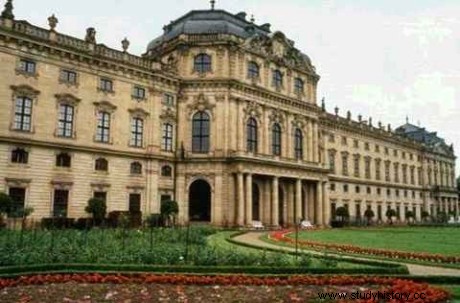
During the Stone Age, German forests were populated by groups of hunters and gatherers. They constituted the primitive forms of Homo sapiens, (Man from Heidelberg who lived 400,000 years ago).
About 2300 BC. new hordes of Indo-European peoples arrived, ancestors of the Germans, who settled in northern and central Germany, the Baltic peoples and Slavs in the east and the Celts in the south and west. From 1800 to 400 BC, the Celtic peoples of southern Germany and Austria made progress in working with metal, configuring various cultures — urn fields, Hallstatt and La Tène — that spread across Europe.
Between the 2nd century BC and V A.D. the Germanic and Celtic tribes were in contact with the Romans, who controlled southern and western Europe and tried unsuccessfully to extend their rule as far as the river Elbe. The border remained on the rivers Rhine and Danube, where the limes (line of fortifications) were erected. In the 4th and 5th centuries, the Huns from Asia ravaged the territory and the Ostrogoths, Visigoths, Vandals, Franks, Lombards and other Germanic tribes invaded the Roman Empire.
Munich's old town has numerous buildings built in the early 18th century by its Bavarian governors. The gathering (in the foreground) dominates the famous Marienplatz square. The Frauenkirche, a tiled cathedral from the late Gothic period, is next to the concourse. The temple was built in the 15th century and its tower measures 99 meters.
In the late 5th century, the head of the Franks, Clodoveus I, defeated the Romans and established a kingdom that encompassed most of Gaul and southeastern Germany. His work was continued in the 8th century by Charlemagne, who annexed southern Germany and subdued the Saxons. The Carolingian Empire did not survive and after the death of Charlemagne's son it was divided among his three grandchildren (see Treaty of Verdun of 843), leaving Germany to Louis the German.
After the death of the last Carolingian monarch, Otto I the Great was the first Saxon king strongly determined to create a centralized monarchy. He granted territorial privileges to the Church, defended his kingdom from outside attacks, and twice invaded Italy. He was crowned Emperor in 962, and is considered the de facto founder of the Holy Roman Empire. The Saxon kings were recognized as emperors for three generations, until the death of Henry the Saint. During the next 100 years (1024-1125), the kings of Germania were elected from among the Franks who ruled the Duchy of Franconia. The Salic kings brought the empire to its culmination.
The city of Nuremberg, in the state of Bavaria, is situated on the banks of the river Pegnitz. In the Middle Ages, Nuremberg was a commercial and cultural center. The castle that appears here was built in the 11th century.
Conrad II the Salicus strengthened royal power by relying on the knights he ennobled. He was succeeded by his son Henry III the Black, who forced the Duke of Bohemia to recognize his authority. At the age of six, Henry IV succeeded his father and during the regency his mother, Agnes of Poitiers, was forced to cede most of the royal territory. Henry IV tried to recover the loss of imperial power which provoked the Saxon rebellion. The result was a nearly 20-year civil war. Henry marched on Rome, installed Antipope Clement III and was crowned emperor in 1084. Finally, betrayed and taken prisoner by his son (Henry V), he was forced to abdicate. Henry V futilely continued his father's struggles to maintain supremacy over the Church, upholding his right to appoint bishops who were simultaneously feudal lords. He lost control of Poland, Hungary and Bohemia. The Investiture Question ended with the Concordat of Worms (1122), which stipulated that episcopal appointments would take place before the imperial presence and the emperor would invest the candidate with the symbols of his temporal office, before a bishop did so with spiritual symbols. .
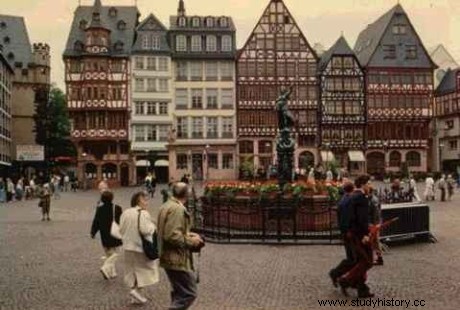
Frankfurt am Main is an active port city situated on the banks of the River Main. This image shows the medieval architecture of the old town.
In the twelfth and thirteenth centuries Germany and Italy were immersed in the rivalry between two princely families:the Hohenstaufen of Swabia, called Ghibellines (see Guelphs and Ghibellines) in Italy, and the Welfs from Bavaria and Saxony, known as Guelphs in Italy.
On the death of Henry V, the princes elected Emperor Lothair II, Duke of Saxony, who tried to convert and dominate the east. After his death, the princes elected Conrad of Hohenstaufen, Duke of Swabia, and civil war erupted again (Guelph - Ghibellines) as Conrad led the ill-fated Second Crusade, which developed parallel to the Guelph-Ghibelline conflict in Italy.
His son Frederick I Barbaroxa assumed the title of Holy Roman Emperor. He unified Germany and Burgundy, declared an imperial peace, and subjugated the Guelphs.
Henry VI wanted to expand his domains. To ensure peace in Germany, he put down a rebellion, invaded northern Italian cities, conquered Sicily, and tried to create a Mediterranean empire that quickly dismembered. His son Frederick II inherited Sicily, but northern Italy reasserted its independence. To gain support for his campaigns in northern Italy, he allowed German princes to be absolute masters in their own territories. He conquered the main Christian places in the Holy Land, except Jerusalem, and after the wars with the Lombard League he took the Papal States.
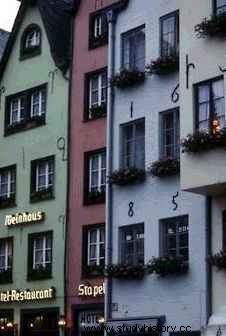
In the image, the older buildings contrast with the neon signs
The old part of the city of Cologne was separated from the modern by the Ringstraáe, built between 1881 and 1895. The modern districts of Cologne emerged as a support to the development of commercial and nautical industries.
Frederick's youngest son inherited Sicily and the imperial title, but Italy and Germany were never united again. The popes, allied with the French, expelled the Hohenstaufen from Sicily. Germany suffered the disorder of the Gran Interregnum (1254-1273), during which the innumerable states into which it was divided staged a return to isolationist feudalism.
By the end of the 13th century, the Empire had lost Poland, Hungary and effective control of Burgundy and Italy. Within their borders, the principalities were practically autonomous. In the cities, the commerce had a great development. The cities on the Rhine and later the northern German cities formed trade associations; the most powerful of which was the Hanseatic League.
At the end of the Middle Ages, the great lines of dukes were extinguished and new principalities were created. Three royal houses—Habsburg, Wittelsbach, and Luxembourg—fought for dynastic rights to the imperial crown. In 1273 the Gran Interregnum came to an end with the election of Rudolph I of Habsburg, who dedicated himself to expanding his family's possessions.
During the reign of Sigismund of Luxembourg the Council of Constance (1414-1418) was convened. The Hussite movement convulsed Bohemia by combining traditional Czech sentiments with a desire to profoundly reform the Church.
With his stepson Albert V the Illustrious, the imperial crown became hereditary to the House of Habsburgs. His successor, Frederick III of Styria, lost Hungary and Bohemia, and sold Luxembourg to France, while fighting the German princes and the Turks reaching the borders of the Empire.
Maximilian I developed a marriage policy for the benefit of his family. His marriage to Marie of Burgundy entitled him to the inheritance of Duke Charles the Bold, which included the territory between present-day Switzerland and the sea, with Flanders and Holland. Through the marriage of his son, Felipe I, the Beautiful, with the heiress of Spain, Joana I, the Mad, Maximilian laid the foundations for the future union of the crowns of Castile and Aragon with the Empire. As in the rest of Europe, the 15th century was a time of transition from the feudal economy of the Middle Ages to the money economy of the modern age, a process that created tensions between all classes of society, as cities became increasingly important.
Martin Luther's spiritual anxieties combined with the secular ambitions of German princes to produce the Protestant Reformation, which proposed religious freedom. Religious struggles intensified European political conflicts for a hundred years.
In 1519 Charles (I of Spain and V of Germany) succeeded his grandfather Maximilian as Holy Roman Emperor. He dedicated his life to preserving a medieval empire united in faith, a fruitless effort in the plural society created by reformers and secular forces. The Protestants were divided:in addition to the Lutherans, there were reformist Christians inspired by the Swiss theologian Ulrich Zwingli and Anabaptist radicals.
By the Peace of Augsburg (1555), Lutheranism was recognized, but not so with Calvinists (see John Calvin). Charles abdicated in 1556. His vast empire was divided:the Spanish and Burgundian possessions passed to his son Philip II, while the imperial title and German possessions went to his brother Ferdinand I of Habsburg.
While Emperors Ferdinand I and his son Maximilian II were busy with the threat of Turkish invasion, Protestantism expanded in Germany, but its progress was halted by the Counter-Reformation. The Council of Trent (1545-1563) modified Catholic doctrine and worship and prevented reconciliation with Protestants.
The tension between both religions led to the Thirty Years' War, which ended with the Peace of Westphalia (1648). The sovereignty and independence of each state of the Holy Roman Empire was recognized and the religion would be determined by its prince; the situation existing in 1624 in the religious aspect was accepted, establishing that the properties of the Habsburgs, the south and the west of Germany were Catholic and the Protestants could keep the acquired properties.
Politically, the Holy Roman Empire (or I Reich) continued with that name, but it had lost all pretensions to universality and centralized government. In the late 17th and early 18th centuries, the Empire was eclipsed by France and England. The imperial structure depended on a large number of lesser princes; the Wettins of Saxony, the Welfs of Brunswick-Lüneburg became electors of Hannover, the Wittelsbachs of Bavaria, the Habsburgs of Austria and the Hohenzollerns of Brandenburg were the hegemonic families in the Empire and dominated the other princes.
They had only recovered from the Thirty Years' War when the princes and emperor faced off in a series of new dynastic struggles. In the west, the princes were involved in four wars to put a stop to Louis XIV's intentions to extend French territory as far as the Rhine.
The German princes headed to the north and east, where they came into conflict with Sweden in the Baltic Sea, producing two wars, called the North. The Germans also had to face the Ottoman Turks, who expanded into southeastern Europe. Eugene of Savoy defeated them at Senta (1697) and the Habsburgs annexed most of Hungary. The Hohenzollern family had geographically disconnected territories in the west. Outside the Empire, the most important area was Prussia, which became an independent kingdom in 1701.
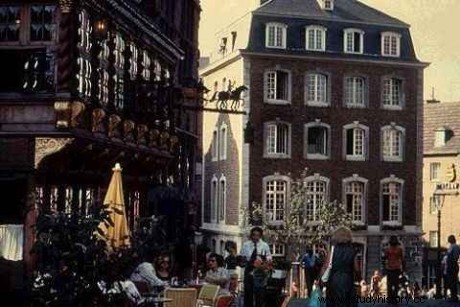
The city of Aachen, in the German Rhineland, is an industrial and tourist center. Probably also Charlemagne's hometown
Frederick William I of Prussia was a military man dedicated to uniting his scattered possessions into a single modern state where the military's presence would be constant. Frederick II the Great devoted most of his life to extending Prussia's territory at the expense of Austria and Poland.
Emperor Charles VI, anxious to keep the Habsburg domains unified, enacted the Pragmatic Sanction in 1713, declaring that his daughter Maria Theresa I of Austria would succeed him. When he died in 1740, voters in Bavaria and Saxony rejected the Pragmatic Sanction. Frederick II invaded Silesia, precipitating the War of the Austrian Succession (1740-1748). Maria Theresa signed peace with him in 1742, ceding Silesia to him.
Prussia's emergence as a great power led to a shift in alliances and new hostilities. Maria Theresa's intention to reconquer Silesia gave rise to a series of alliances that would lead to the Seven Years' War (1756-1763).
For 18 years, the German states were involved in different ways in five wars against the armies of revolutionary and Napoleonic France. At first Austria and Prussia lost many territories, but in 1812 Napoleon was defeated in the Russian campaign. Frederick William III of Prussia, along with Austria and Russia, defeated Napoleon at Leipzig (1813). At the Congress of Vienna (1814-1815) Napoleon's victorious states redrawn the map of Europe. The Holy Roman Empire, with more than 240 states, was replaced by the German Confederation, made up of 39 states represented in the Diet of Frankfurt. Many Germans wanted to establish a liberal government according to a constitution that guaranteed popular representation and other measures. They also had hopes for national unification.
The sovereigns of Prussia and Austria and the newly crowned kings of Bavaria, Hannover, Württemberg and Saxony, fearful of any usurpation of their sovereignty, opposed liberalism and nationalism. Austria, Prussia, Russia and Great Britain formed the Quadruple Alliance to suppress any threat to the Vienna accords.
The liberal revolutions of 1830 and 1848 in Paris spread over Europe. Clashes also reached Bavaria, Prussia, and southwestern Germany, but were quickly crushed in Austria, Hungary, and Prussia.
Prussia and Austria made divergent plans for future German unification. In Prussia, King William I, together with his prime minister, Otto von Bismarck, decided to make Prussia a powerful state.
After the Austro-Prussian War, Austria ceded Venice to Italy, and Prussia annexed Schleswig-Holstein, Hannover, and other states, and organized the North German Confederation (1867) without Austria. Bismarck culminated his strategy with the Franco-Prussian War, after which, in 1871, William was proclaimed Emperor of the German Empire (the Second Reich).
Once the various German states were unified under the Prussian-led Empire, Bismarck made a series of alliances to protect Germany from any outside aggression. Inland he fomented the Industrial Revolution.
Bismarck considered that the Catholic Church threatened the supremacy of the German state. He thus initiated the Kulturkampf (cultural struggle) during which he suppressed many religious orders.
The Empire did not function democratically. Bismarck directed the persecution to the Socialist Party, precursor of the German Social Democratic Party, and was preparing to suppress the Constitution. However, the new Emperor Wilhelm II of Prussia removed him, for wanting to govern the Empire in a personal way.
William II maintained the Triple Alliance (1882) of Germany, Austria and Italy. To balance the situation, Russia agreed to an alliance in 1894 with France. Britain, long neutral, resolved its colonial differences with France and Russia, resulting in the formation of the Triple Entente. In this way, Europe was divided into two armed blocs.
The crisis in Morocco and the Balkans intensified the antagonisms. William II twice intervened in Morocco (1905, 1911), which France intended, to protect German interests in Africa. Austria annexed the Turkish provinces of Bosnia and Herzegovina in 1908. The assassination of Austrian Archduke Franz Ferdinand of Habsburg in Sarajevo in June 1914 was the spark that started World War I.
German troops invaded and advanced through neutral Belgium with the intention of taking Paris by surprise, but the Germans encountered more resistance in Belgium than they expected, despite almost reaching Paris. However, the British and French held back the German advance at the Battle of the Marne, while the Russians attacked from the east, plunging Germany into the dreaded war on two fronts.
The Germans defeated the Russians several times. The Allies blocked Germany to make it impossible to supply food and raw materials, with the support of the United States, which entered the war in 1917. Russia asked for peace, which was signed in 1918. The Germans launched a final offensive in west, but the allies resisted.
The chancellor announced that William II had abdicated and resigned. The leader of the Social Democratic Party Friedrich Ebert proclaimed the Republic. Germany had to face the harsh terms of the Treaty of Versailles in 1919:it lost Alsace and Lorraine to France, and West Prussia passed to Poland. It also lost its colonies and had to give up its steelworks, railway lines and merchant ships, as well as its naval strength. Furthermore, they had to accept full responsibility for causing the war and pay reparations to the winning countries.
The economic crisis made the situation worse. Under the Dawes Plan (1924), the amount and method of paying war reparations was revised and loans from abroad were provided. For five years Germany enjoyed relative social stability and prosperity; in 1926 it joined the League of Nations. However, the world economic crisis of 1929 put the country once again on the brink of disaster.
In the midst of economic depression, the 1932 elections made the National Socialist (Nazi) Party the most represented in the Reichstag. In 1933, with the support of far-right elements, Hitler was elected chancellor. The new Parliament passed the Special Powers Act allowing Hitler to control all aspects of German life and create the Third Reich.
All political parties except the National Socialist were considered illegal. The Third Reich sought to be economically self-sufficient. The broad propagandistic system had the support of the Gestapo in the repression of the disaffected. Jews suffered from discriminatory laws, being deprived of citizenship and excluded from civil and professional activities, and after the so-called Night of Broken Crystals, hundreds of thousands of Jews fled the country.
Later, the occupations of France, Belgium, the Netherlands, Norway, Denmark, Yugoslavia and Greece brought millions of Jews under Nazi rule. By the end of the war, dead Jews numbered around six million in what became known as the Holocaust.
Germany's desire to seek a revision of the Treaty of Versailles by force rendered useless efforts by other countries that wanted to avoid military confrontation, which led to World War II, in which the Germans were allies of Mussolini's Italy and Japan. expansionist.
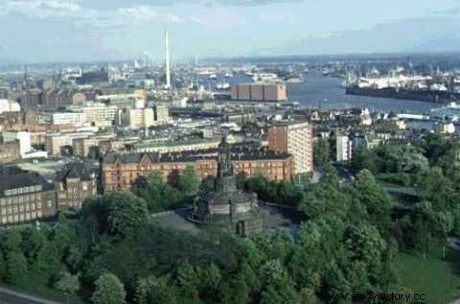
The port city of Hamburg, situated on the banks of the River Elbe near the North Sea, had to be almost entirely rebuilt after World War II. The monument to Otto von Bismarck is situated in the foreground with the city in the background. Bismarck, first chancellor of the German Empire, ruled from 1871 to 1890
The first phase of operations was largely favorable to Axis forces, which occupied Poland, Belgium and France, as well as eastern Europe. In 1942, however, Britain was still resisting and the United States had entered the war after the Japanese attack on Pearl Harbor. In 1943, the Soviet offensive gradually drove German troops westward. Axis forces in North Africa were defeated and Italy was invaded. Germany, from 1942, began to be bombed intensively, but Hitler refused to surrender. British and American forces landed in Normandy in 1944 and advanced towards the German border, while the Soviets did the same on the eastern front. Hitler committed suicide before Soviet tanks entered Berlin in April 1945.
Germany's unconditional surrender ended the Third Reich. The allies reduced Germany to the borders before the beginning of the conflict, and even allocated a part of its eastern territory to Poland, as a way of compensating for the lands occupied by the Soviet Union up to the Oder. Germany was divided into four occupation zones, but as the political orientations of the Allies diverged, Germany was practically divided into two parts. In 1948, Great Britain, the United States and France united their occupation zones and encouraged the Germans to form a democratic government. The USSR, in turn, created another state. In 1949 two German states were formed:the Federal Republic of Germany, or West Germany and the German Democratic Republic or East Germany.
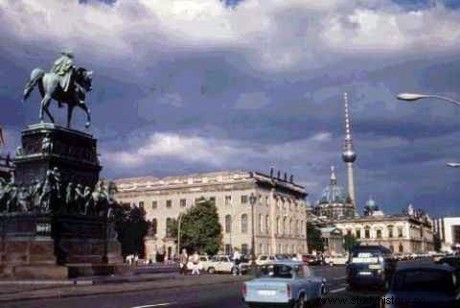
Berlin is the capital and largest city in Germany. Located in the northeast of the country and connected by rivers and canals with the Baltic Sea, it is also an important industrial and cultural center
East German government fell in 1989. With the fall of the Berlin Wall and other migratory barriers more than 200,000 East Germans entered West Germany. Both Germanys realized the economic and monetary union in July 1990, and in October the German Democratic Republic was dissolved:all its citizens became subjects of the German Federal Republic. The conservative coalition led by Helmut Kohl, which had been in power since 1982, won the 1990 elections. Kohl remained in charge of the new Germany until 1998, when he lost the election to Social Democrat Gerhard Schroeder, who won more than 5 % of upvotes. Schroeder is the third Social Democrat chancellor since 1949, after Willy Brandt (1966-1969) and Helmut Schmidt (1974-1982).
Take the opportunity to check out our video lesson related to the subject:
